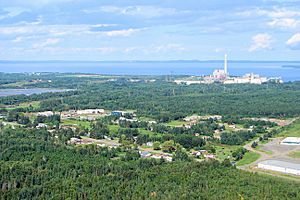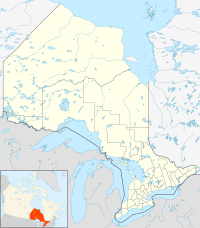Fort William First Nation facts for kids
Quick facts for kids
Fort William 52
|
|
|---|---|
| Fort William Indian Reserve No. 52 | |
 |
|
| Country | |
| Province | |
| District | Thunder Bay |
| First Nation | Fort William |
| Area | |
| • Land | 58.50 km2 (22.59 sq mi) |
| Population
(2021)
|
|
| • Total | 964 |
| • Density | 16.5/km2 (43/sq mi) |
| Website | fwfn.com |
Fort William First Nation (also called Animkii Wajiw in Ojibwe) is a community of the Ojibwa people in Ontario, Canada. It is a First Nation reserve. Their main office is located south of Thunder Bay. In 2008, about 1,798 people were part of the First Nation, with 832 living on the reserve.
The Fort William First Nation has a large arena with two ice rinks. It's where the Thunder Bay Bearcats hockey team plays. There is also a fitness center. A business park in the community is home to the main offices of Wasaya Airways and other businesses.
Contents
- Fort William Reserve: The Land Base
- History of Fort William First Nation
- Geography and Landscape
- Mount McKay: Animkii Wajiw
- Transportation in the Community
- Governance and Leadership
- Environmental Care: Anishinabek Gitchi Gami Environmental Programs
- Animikii Wajiw Miinigoowizwinan Charitable Foundation
- Notable People from Fort William First Nation
Fort William Reserve: The Land Base
The Fort William First Nation has its own land, called the Fort William Indian Reserve 52. This reserve covers about 5,815 hectares (or 14,369 acres). This land is very important to the First Nation.
History of Fort William First Nation
How the Reserve Was Created
The Fort William Reserve is located on the western side of Lake Superior, next to the city of Thunder Bay. This land was set aside for the First Nation in 1850. This happened as part of an agreement called the Robinson-Superior Treaty.
The land is on the edge of the Canadian Shield, which is a huge area of ancient rock and waterways. The Ojibwa people of Fort William traditionally used a large area for hunting and fishing. This area stretched from the Pigeon River in the south to the Treaty 9 boundary in the north, and east to Lake Nipigon.
The Fort William Reserve was officially created in 1853. The leaders who signed the treaty wanted the reserve to provide for their people for many generations. However, over time, much of the best land on the reserve was taken away.
The Robinson-Superior Treaty Agreement
During the treaty talks, Fort William First Nation agreed not to stop new settlers from moving into the area. In return, the Canadian government (called "the Crown") made promises. These promises included cash payments and trade goods, yearly payments starting in 1851, and the freedom to hunt and fish as they always had. They were also promised a reserve at Fort William.
Life in the Community Long Ago
At the time of the treaty, Fort William First Nation was a busy community. Most people lived by traditional hunting and fishing. They also traded furs and bought supplies at the nearby Hudson’s Bay Post. About ten families worked in commercial fishing. They would sell many barrels of salted fish each year to places like Detroit.
Some members of the Fort William First Nation lived near the Jesuit Mission. Others, known as "interior Indians," spent their winters in their hunting grounds. These interior Indians were not Christian and followed traditional spiritual practices.
The First Nation called the fishing areas on Lake Superior "The Grand Fishery." This included islands off Pie Island and areas south to Sturgeon Bay. These important fishing grounds were not fully protected in the 1850 treaty. The Fort William Indians sent many requests to the Crown between 1852 and 1895 to protect their fishery.
Since the 1850 treaty, Fort William First Nation has worked hard to become self-sufficient. They aim to be a center for Indigenous businesses and communities in Northwestern Ontario.
Geography and Landscape
Fort William First Nation has a varied landscape along the shore of Lake Superior. Near the lake, much of the reserve is swampland. However, the western part of the reserve has mountains, including the Nor'Wester mountains and Loch Lomond.
Most homes in the First Nation are in a village on Mission Road. There is also a trailer park near Chippewa Park. Many cottages are located along Sandy Beach Road.
Mount McKay: Animkii Wajiw
Mount McKay is a large rock formation located south of Thunder Bay, Ontario. It is on the Fort William First Nation reserve. This mountain formed about 1,100 million years ago.
Cultural Importance of Mount McKay
The Ojibwe people originally called Mount McKay "Thunder Mountain" (Animkii Wajiw). The mountain is a sacred place used by the Ojibwe for important ceremonies. For a long time, only First Nation members were allowed on this land. Non-First Nation people were only allowed after a road was built.
Exploring Mount McKay
There is a lookout point on the lower eastern part of the mountain. It is about 300 meters (984 feet) high. From here, you can see amazing views of Thunder Bay and its harbor. There is also a small memorial that honors Indigenous people who fought in wars.
You can hike on a path on the eastern side of the mountain. Some plants found on the mountain include red and sugar maple trees, and poison ivy. The Ojibwe name for poison ivy is animikiibag, meaning "thunder-leaf." The top of the mountain has large rocks left by glaciers and jack pine trees. A small group of yellow birch trees grows near the entrance gate.
There is also a difficult trail to the very top from the lookout. It has a steel cable for support. However, this hike is considered dangerous because of the steepness and loose rock (shale). It is not recommended for people who are not experienced hikers. A less dangerous trail is on the west side of the mountain, also with shale.
Mount McKay is the northernmost peak in a group of mountains called the Nor’Wester Mountains.
Transportation in the Community
The main roads in Fort William First Nation are Mission Road and Squaw Bay Road. The community on Mission Road has local bus service. Thunder Bay Transit provides Route 6 Mission, which serves the community several times a day from Monday to Friday.
Governance and Leadership
Traditional vs. Modern Governance
Like many other First Nations in Canada, Fort William First Nation has both traditional ways of governing and a system put in place by the Canadian government. The "Chief and Council" system was introduced to First Nations across the country. This system made leaders more accountable to the Canadian government than to their own people.
However, traditional Anishinaabe law and governance are still practiced in the community. Anishinaabe governance is more flexible. Individuals and families work together to make decisions important to the community. For example, the Robinson-Superior Treaty was signed by two Fort William chiefs, not just one. Families still follow Anishinaabe citizenship law, which respects the community's right to decide who belongs.
For many years, the Fort William Chief and Council system followed the Indian Act. But on April 15, 2019, the band held its first election under the First Nations Election Act.
Membership and Representation
As a signatory to the Robinson-Superior Treaty, Fort William First Nation is a member of Anishinabek Nation. This is a political group that represents many Anishinaabe First Nation governments in Ontario, especially those around Lake Superior and Lake Huron.
Current Leadership
The First Nation elects its leaders through a system that includes a Chief and twelve councilors. The current Chief is Peter Collins. His two-year term started on April 15, 2017. The councilors are Leo Bannon Sr., Leo Bannon Jr., Murray Pelletier, Catherine McKenzie, Valerie Chapman, Jennelle Charlie, Anthony Collins, Kyle Maclaurin, Michele Solomon, Philip Pelletier, Yvette Greenwald, and Sherry Pelletier.
Environmental Care: Anishinabek Gitchi Gami Environmental Programs
Fort William First Nation has faced pollution issues from industries in the past and present. Because of this, community members created their own group to improve health and the environment. Between 2007 and 2009, they formed a non-profit environmental group called Anishinabek Gitchi Gami Environmental Programs (AGG). This group works to address threats to human and environmental health.
The AGG was the first environmental non-profit organization in an Ontario First Nation community. Its name comes from the original name for the community, "Chippewas of the Gitchigami." "Anishinabek Gitchi Gami" means "the people of 'Lake Superior'" in the Ojibwe language.
Animikii Wajiw Miinigoowizwinan Charitable Foundation
In late 2014, Fort William First Nation worked to create a charity called Animikii Wajiw Miinigoowizwinan Charitable Foundation. In the Ojibwe language, Animikii Wajiw Miinigoowiziwinan means "Thunder Mountain Gifts." The foundation's office is located at 90 Anemki Drive, Suite 200, Fort William First Nation, ON P7J 1L3.
Notable People from Fort William First Nation
- Mel Pervais, a successful business person
- Yolanda Bonnell, an actress and writer for plays
- Tanya Talaga, a journalist and author


